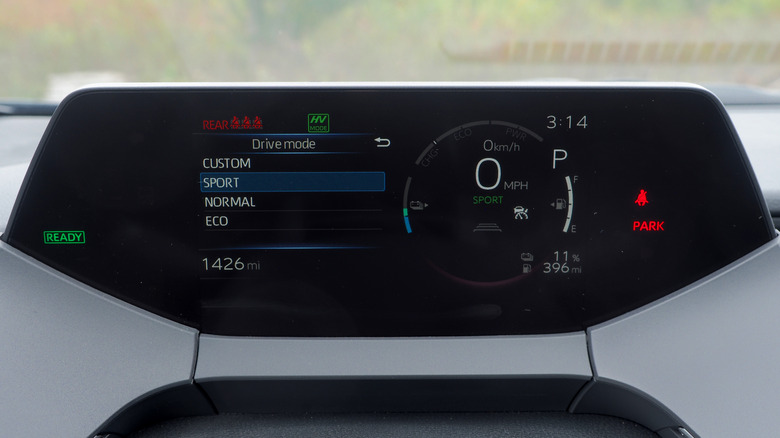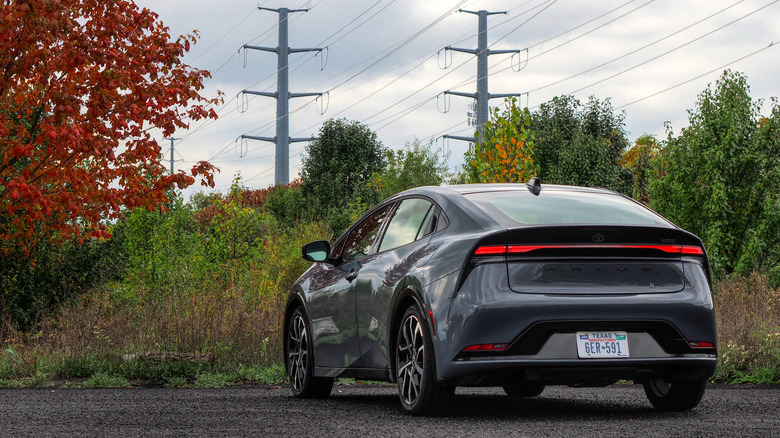2023 Prius Prime Solar Roof: How Quickly Does It Charge?
With green power generation often centering on solar, and electrified cars requiring regular recharging, you'd be forgiven for wondering why more automakers don't take Toyota's strategy of offering a solar roof for the new 2023 Prius Prime. For $610, the plug-in hybrid's normal roof is replaced by a glass panel laced through with photovoltaic cells. After all, who doesn't love the idea of an EV that can charge itself?
The usual justification as to why solar panels on EVs haven't taken off is the poor relative benefit. There's simply not enough surface area to cover with photovoltaic cells, to deliver meaningful levels of power. Electric motors are typically power-hungry things, and even the latest generation of solar panels can't provide sufficient energy to drive them any significant distance. Not for nothing have solar car projects like Aptera's ended up with super-lightweight, aerodynamic-but-odd designs, in an attempt to work around the realities of small-scale solar power generation.
Toyota's angle is different. The solar roof option on the latest-generation Prius Prime will recharge the plug-in hybrid's battery, but the automaker doesn't really intend to move the needle dramatically on the overall driving range. Instead, juice from the 185W panel will help offset adjacent battery hogs, like the climate control and other electronics in the cabin.
Where do you park, and where do you drive?
Whether it's worth the extra spend on top of the Prius Prime's sticker price depends, largely, on where you'll be driving your plug-in hybrid – and where you'll be parking it. Obviously, those owners in sunny states like California and Texas are likely to see the biggest benefits, with plenty of sunshine allowing the Prius Prime's solar roof to deliver year-round power.
Those living in states where the seasons are more changeable, meanwhile, may not recognize quite the same benefits. In Michigan, for example, where I tested the Prius Prime in the fall, overcast skies meant that the solar roof-specific power generation pages in the driver's display didn't show much in the way of gains at all.
Regardless, where you park your PHEV will also impact the solar roof's contribution. If you're charging the Prius Prime in a garage or under a carport, you won't get any sunlight anyway. Given the choice between plugging in a Level 2 home charger — which recharges the battery in around four hours — or getting a minor top-up from the sun, the sensible choice is obvious.
Even in a best-case scenario, this is no fast charge
If you could guarantee sufficient sunlight to keep the Prius Prime's solar roof working at maximum efficiency, then, just how long would it take to recharge the battery? As is usually the case with plug-in hybrids, the Toyota has a smaller Li-ion pack than a fully electric vehicle would be equipped with: the assumption is that while some electric-only driving may be taking place, the gas engine will be picking up the slack.
For this generation of Prius PHEV, Toyota actually increased the battery pack capacity. Specifically, the 2023 Prius Prime comes with a 13.6 kWh pack; Toyota's bZ4X full EV, in contrast, gets a 71.4 kWh pack as standard.
In a best-case scenario, with the solar roof operating at peak efficiency, it'd take around 74 hours of sunlight to fully charge the Prius Prime's battery. If you could somehow guarantee a series of twelve hour days of such conditions, figure on just shy of a week for that "free" recharge. That's assuming you don't actually drive anywhere, mind.
A gimmick, but a fun one
More realistically — but still with no driving — the generally acknowledged modifier is that you'll see around 75% of your solar panel's total wattage output on average. That's meant to take into account varying weather conditions, panel efficiency, and other factors. Altogether, that pushes a full recharge to almost 100 hours, or about a week and a half. As you can see, there are plenty of variations (including how clean your solar roof is in the first place) and then translating that power into miles driven adds another layer of uncertainty.
The EPA rates the Toyota at 39-44 miles of electric-only driving, wheel size depending, though how close you'll get to that estimate will vary based on your driving style, road dynamics, and more. The solar roof could well help power some of those electric miles, though Prius Prime buyers should probably think of it as a fun gadget more than a realistic way to avoid plugging in their PHEV.



